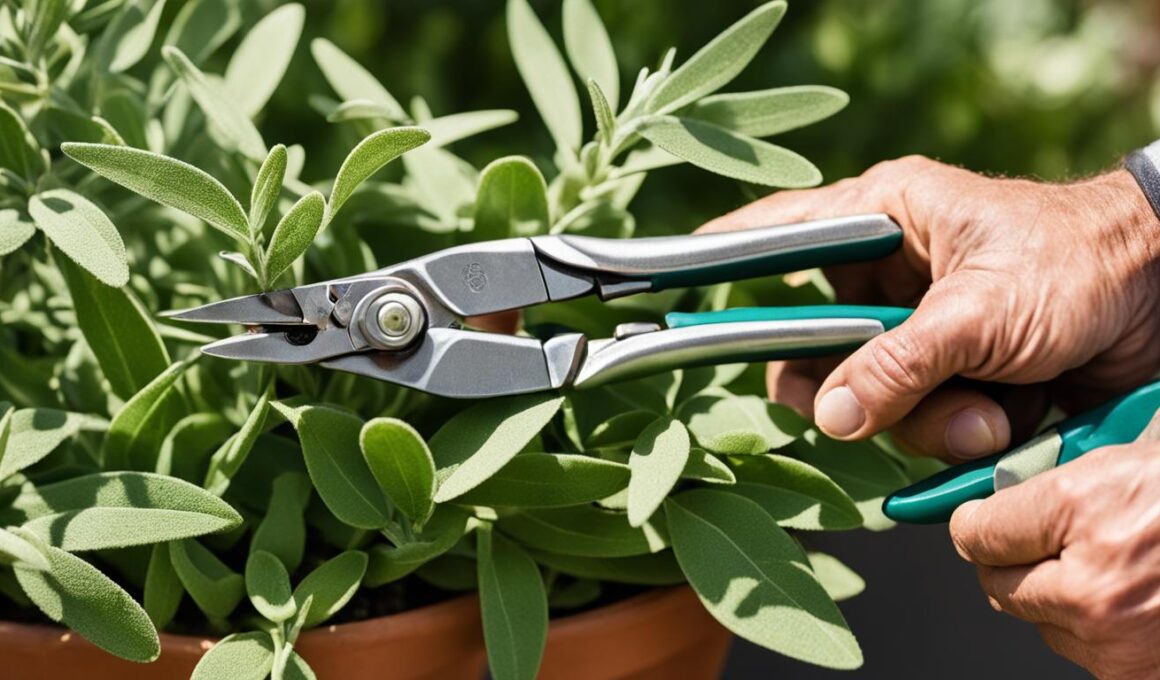In order to maintain healthy sage plants, proper pruning is essential. Pruning sage is best done during the springtime when new growth begins to emerge. By pruning at this time, you can ensure that the plants will thrive and produce abundant foliage throughout the season.
Pruning sage plants involves cutting back the stems to a length of 4-6 inches from the ground. This helps to prevent the plants from becoming tall and falling over, while also encouraging new shoots to grow. Use sharp scissors or garden shears to make clean cuts and remove any dead or dying leaves throughout the year. Removing these leaves not only improves the appearance of the plant, but also promotes its overall health and vigor.
During the first year of the plant’s growth, it is advisable to lightly prune sage to allow for full development. Focus on removing damaged or spent leaves to allow for new growth. However, be conservative in cutting away branches to ensure the plant’s strength during colder seasons. By following these pruning techniques, you can enjoy healthy and thriving sage plants all year round.
Tips for Harvesting Sage Leaves
To harvest sage leaves, there are a few techniques you can use. By following these tips, you can ensure that you gather your sage leaves efficiently and preserve their freshness for future use.
Gently pull leaves: Start by gently pulling each leaf from the stem. Pinch the bottom of the leaf between your thumb and forefinger and pull it away from the stem. Most of the time, the leaves should come off easily without the need for cutting.
Use scissors or garden shears: If the leaves do not easily detach from the stem, you can use sharp scissors or garden shears to make a cut. Simply position the scissors or shears just below the leaves and trim the stem. This method is especially useful when harvesting larger amounts of sage.
Trim whole stems: To streamline the harvesting process, consider trimming whole stems of sage. Cut the stems about 3-5 inches below their tips. This approach works well if you have a substantial amount of sage to harvest.
After harvesting your sage leaves, it’s essential to give them a thorough rinse. Place the leaves under cold running water, making sure to remove any dirt or debris. Next, dry the sage leaves gently between paper towels to remove excess moisture.
When it comes to storing sage leaves, you have two options. Fresh sage leaves should be used within a week to enjoy their optimal flavor. On the other hand, dried sage leaves can be stored in airtight containers for up to 2 weeks. Regardless of your choice, ensure that the leaves are properly stored to maintain their quality.
Remember, sage is a potent herb, so use it conservatively in your dishes to avoid overpowering the flavors.
Follow these harvesting tips to make the most of your sage plants and enjoy the distinctive flavor and aroma of fresh or dried sage leaves in your culinary creations.
Conclusion
Pruning sage is an essential practice for maintaining the health and vitality of your sage plants. By pruning in the springtime, you can stimulate new growth and prevent your plants from becoming tall and weak. Trimming the stems to a desired length and regularly removing dead leaves throughout the year will contribute to the overall well-being of your sage plants.
When it comes to harvesting sage leaves, there are a few techniques you can use. You can gently pull the leaves off the stem by pinching the bottom of the leaf between your thumb and forefinger. If the leaves are stubborn, you can use scissors or garden shears to cut the stems just below the leaves. For larger quantities of sage, trimming whole stems around 3-5 inches below the tips is more efficient.
After harvesting, make sure to rinse the sage leaves thoroughly with cold water and dry them between paper towels. Fresh sage leaves should be used within a week to enjoy their full flavor, while dried sage leaves can be stored in airtight containers for up to two weeks. Remember that sage is a potent herb, so use it in moderation to avoid overpowering your dishes.
Following these tips for pruning and harvesting sage leaves will ensure that you can enjoy the flavorful benefits of this versatile herb in your culinary creations. Whether you’re adding sage to a savory marinade or infusing it into a comforting tea, the freshness and quality of your sage leaves will elevate the taste of your dishes.
Can Pruning Sage Help in Successful Propagation from Cuttings?
Pruning sage can significantly aid in propagating sage from cuttings. By cutting the stems at a 45-degree angle and removing the lower leaves, you can encourage root growth and increase the success rate of propagation. With the right conditions, propagating sage from cuttings can be a rewarding and successful process.










